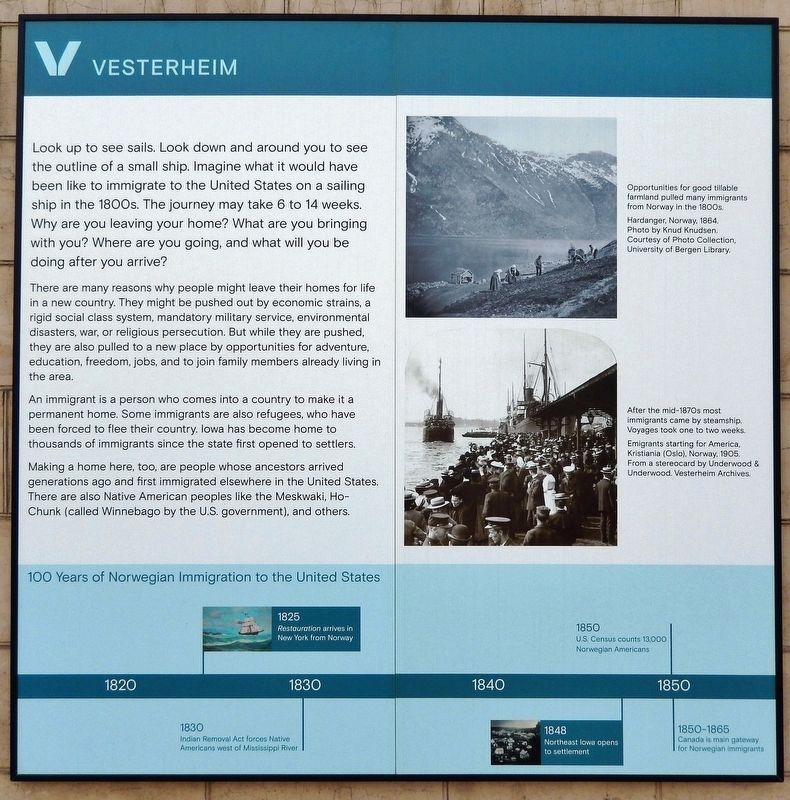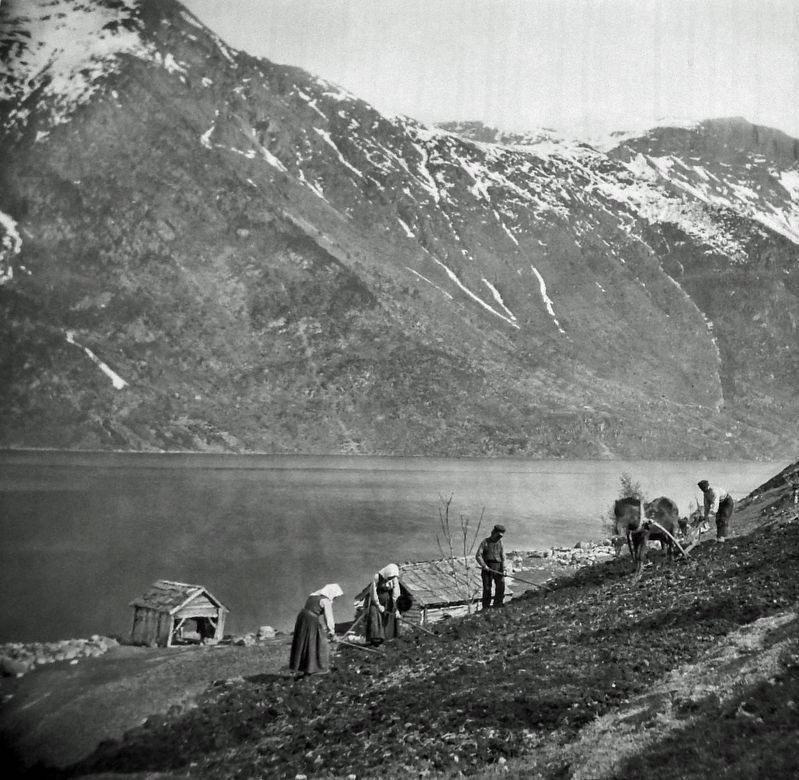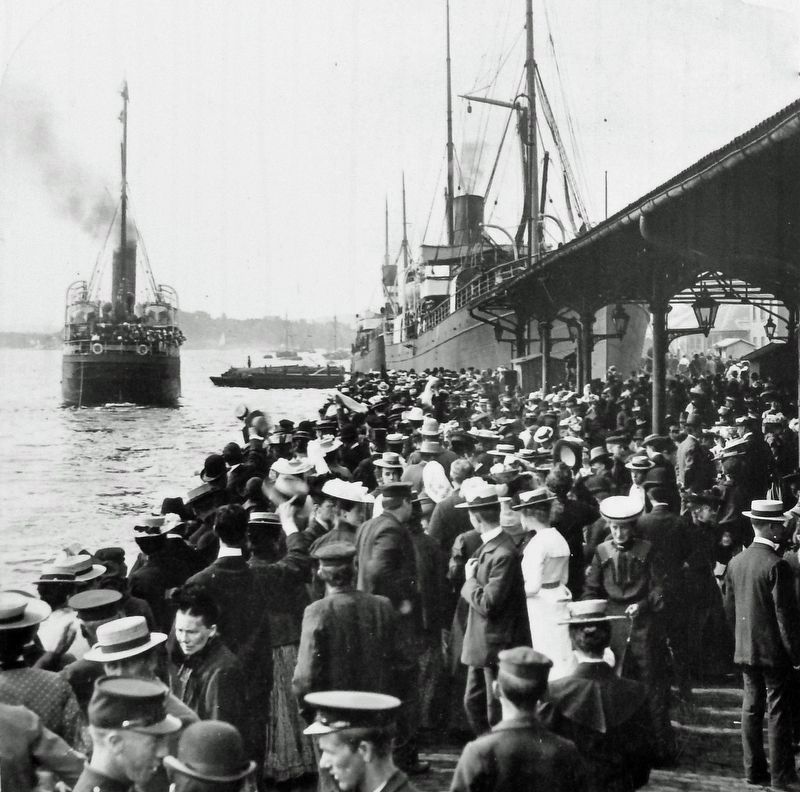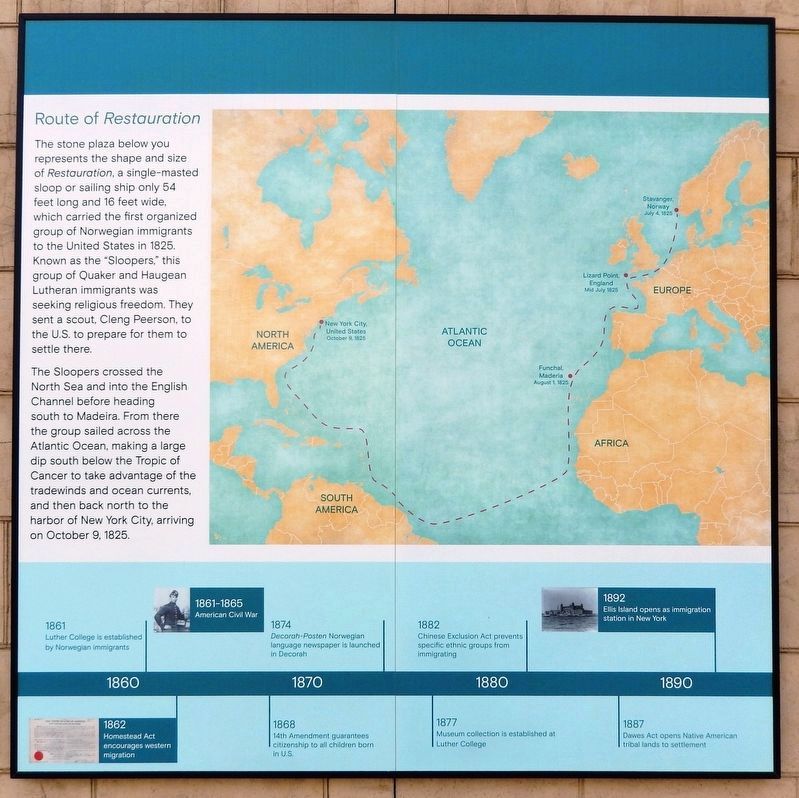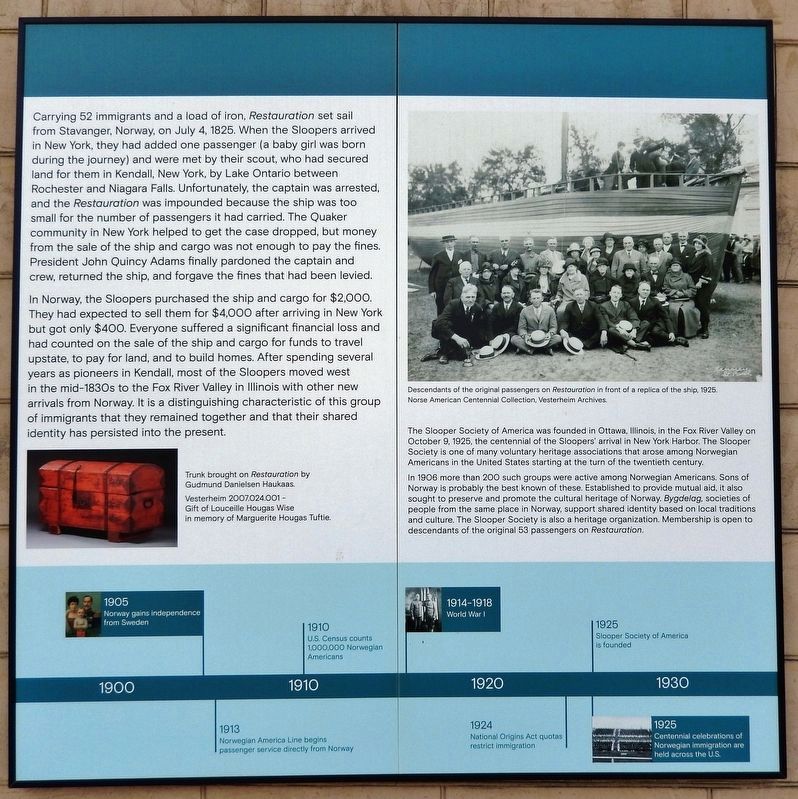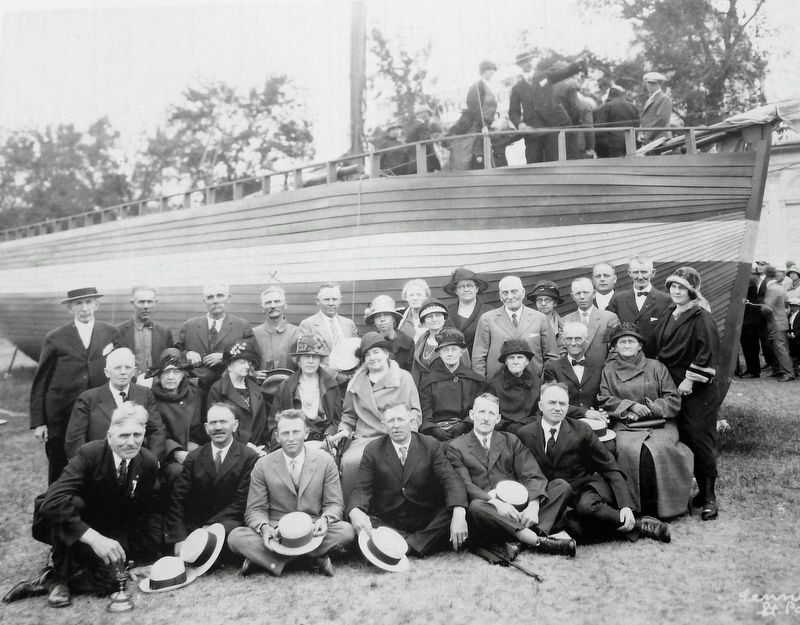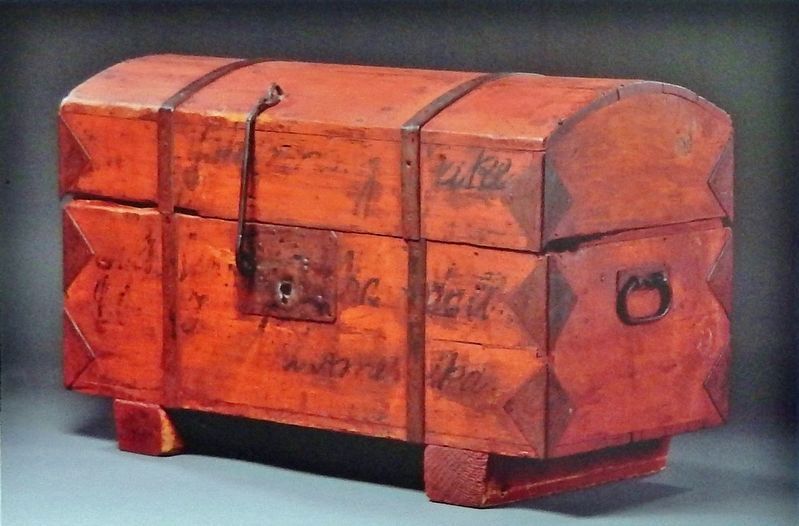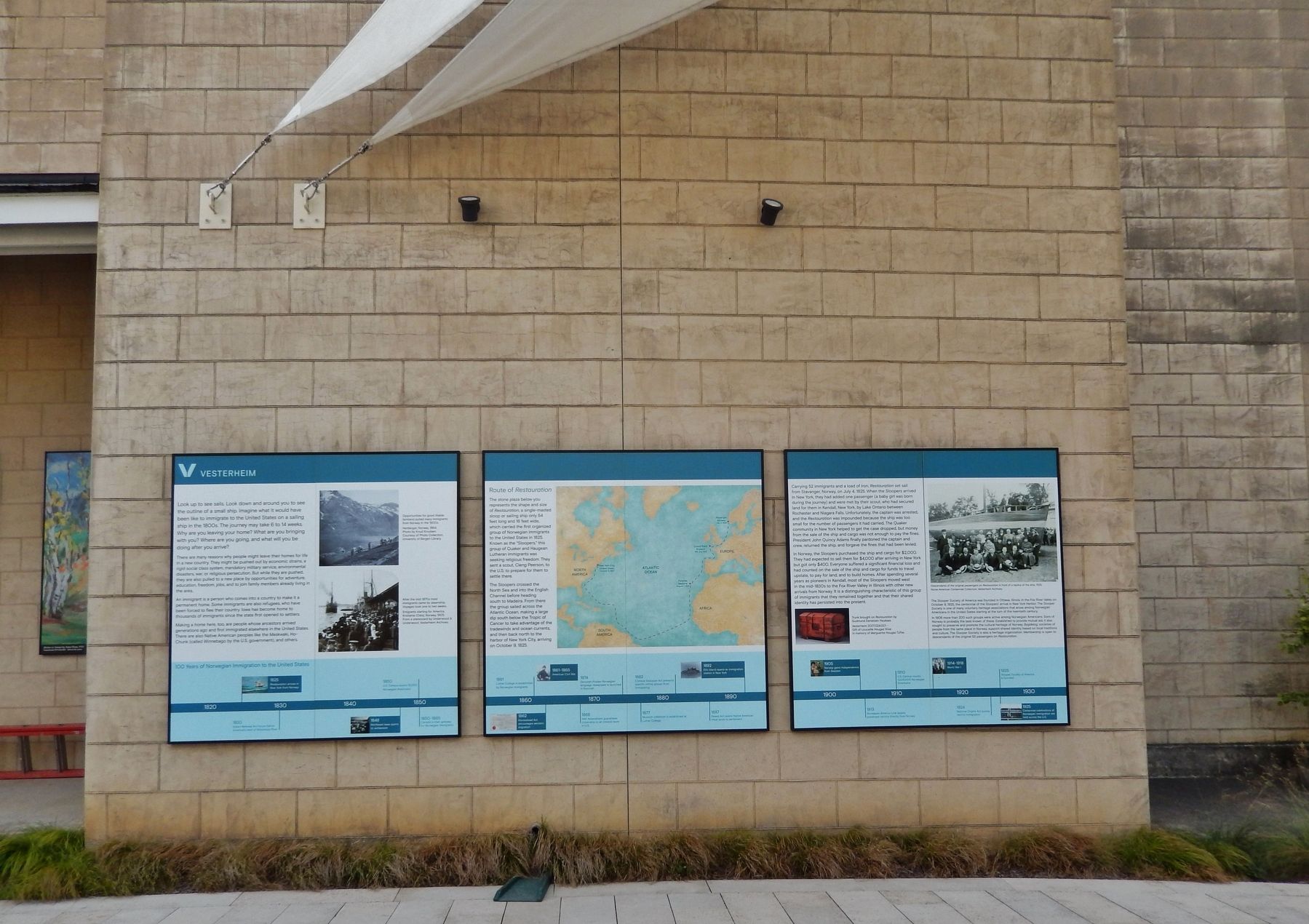Decorah in Winneshiek County, Iowa — The American Midwest (Upper Plains)
Vesterheim
Heritage Park, Vesterheim Norwegian-American Museum
Look up to see sails. Look down and around you to see the outline of a small ship. Imagine what it would have been like to immigrate to the United States on a sailing ship in the 1800s. The journey may take 6 to 14 weeks. Why are you leaving your home? What are you bringing with you? Where are you going, and what will you be doing after you arrive?
There are many reasons why people might leave their homes for life in a new country. They might be pushed out by economic strains, a rigid social class system, mandatory military service, environmental disasters, war, or religious persecution. But while they are pushed, they are also pulled to a new place by opportunities for adventure, education, freedom, jobs, and to join family members already living in the area.
An immigrant is a person who comes into a country to make it a permanent home. Some immigrants are also refugees, who have been forced to flee their country. Iowa has become home to thousands of immigrants since the state first opened to settlers.
Making a home here, too, are people whose ancestors arrived generations ago and first immigrated elsewhere in the United States. There are also Native American peoples like the Meskwaki, Ho-Chunk (called Winnebago by the U.S. government), and others.
Route of Restauration
The stone plaza below you represents the shape and size of Restauration, a single-masted sloop or sailing ship only 54 feet long and 16 feet wide, which carried the first organized group of Norwegian immigrants to the United States in 1825. Known as the “Sloopers,” this group of Quaker and Haugean Lutheran immigrants was seeking religious freedom. They sent a scout, Cleng Peerson, to the U.S. to prepare for them to settle there.
The Sloopers crossed the North Sea and into the English Channel before heading south to Madeira. From there the group sailed across the Atlantic Ocean, making a large dip south below the Tropic of Cancer to take advantage of the tradewinds and ocean currents, and then back north to the harbor of New York City, arriving on October 9, 1825.
Carrying 52 immigrants and a load of iron, Restauration set sail from Stavanger, Norway, on July 4, 1825. When the Sloopers arrived in New York, they had added one passenger (a baby girl was born during the journey) and were met by their scout, who had secured land for them in Kendall, New York, by Lake Ontario between Rochester and Niagara Falls. Unfortunately, the captain was arrested, and the Restauration was impounded because the ship was too small for the number of passengers it had carried. The Quaker community in New York helped to get the case dropped, but money from the sale of
the ship and cargo was not enough to pay the fines. President John Quincy Adams finally pardoned the captain and crew, returned the ship, and forgave the fines that had been levied.
In Norway, the Sloopers purchased the ship and cargo for $2,000. They had expected to sell them for $4,000 after arriving in New York but got only $400. Everyone suffered a significant financial loss and had counted on the sale of the ship and cargo for funds to travel upstate, to pay for land, and to build homes. After spending several years as pioneers in Kendall, most of the Sloopers moved west in the mid-1830s to the Fox River Valley in Illinois with other new arrivals from Norway. It is a distinguishing characteristic of this group of immigrants that they remained together and that their shared identity has persisted into the present.
The Slooper Society of America was founded in Ottawa, Illinois, in the Fox River Valley on October 9, 1925, the centennial of the Sloopers' arrival in New York Harbor. The Slooper Society is one of many voluntary heritage associations that arose among Norwegian Americans in the United States starting at the turn of the twentieth century.
In 1906 more than 200 such groups were active among Norwegian Americans. Sons of Norway is probably the best known of these. Established to provide mutual aid, it also sought to preserve and promote the cultural
heritage of Norway. Bygdelag, societies of people from the same place in Norway, support shared identity based on local traditions and culture. The Slooper Society is also a heritage organization. Membership is open to descendants of the original 53 passengers on Restauration.
100 Years of Norwegian Immigration to the United States
1825 Restauration arrives in New York from Norway
1830 Indian Removal Act forces Native Americans west of Mississippi River
1848 Northeast Iowa opens to settlement
1850 U.S. Census counts 13,000 Norwegian Americans
1850-1865 Canada is main gateway for Norwegian immigrants
1861 Luther College is established by Norwegian immigrants
1861-1885 American Civil War
1862 Homestead Act encourages western migration
1868 14th Amendment guarantees citizenship to all children born in U.S.
1874 Decorah-Posten Norwegian language newspaper is launched in Decorah
1877 Museum collection is established at Luther College
1882 Chinese Exclusion Act prevents specific ethnic groups from immigrating
1887 Dawes Act opens Native American tribal lands to settlement
1892 Ellis Island opens as immigration station in New York
1905 Norway gains independence from Sweden
1910 U.S. Census counts 1,000,000 Norwegian Americans
1913 Norwegian America Line begins passenger service directly from Norway
1914-1918 World War I
1924 National Origins Act quotas restrict immigration
1925 Slooper Society of America is founded
1925 Centennial celebrations of Norwegian immigration are held across the U.S.
Erected by Vesterheim Norwegian-American Museum.
Topics and series. This historical marker is listed in these topic lists: Immigration • Native Americans • Settlements & Settlers • Waterways & Vessels. In addition, it is included in the Former U.S. Presidents: #06 John Quincy Adams series list. A significant historical date for this entry is October 9, 1825.
Location. 43° 18.271′ N, 91° 47.512′ W. Marker is in Decorah, Iowa, in Winneshiek County. Marker can be reached from West Water Street just east of North Mill Street, on the left when traveling east. The marker is mounted on the east wall of the Vesterheim Norwegian-American Museum. Touch for map. Marker is at or near this postal address: 520 West Water Street, Decorah IA 52101, United States of America. Touch for directions.
Other nearby markers. At least 8 other markers are within walking distance of this marker. Welcome to Vesterheim (within shouting distance of this marker); Norsvin Mill (within shouting distance of this marker); Decorah: A Walk into the Past (within shouting distance of this marker); Valders House (within shouting distance of this marker); Egge-Koren House (within shouting distance of this marker); Stabbur (within shouting distance of this marker); a different marker also named Decorah: A Walk into the Past (within shouting distance of this marker); Rovang Schoolhouse (within shouting distance of this marker). Touch for a list and map of all markers in Decorah.
More about this marker. This marker consists of three panels mounted side-by-side on the east wall of the Vesterheim Norwegian-American Museum.
Related markers. Click here for a list of markers that are related to this marker. Vesterheim Norwegian-American Museum Heritage Park
Also see . . . Restauration (Wikipedia). Excerpt:
Restauration was a sloop built in 1801, in Hardanger, Norway. It became a symbol of Norwegian American immigration. On what is considered the first organized emigration from Norway to the United States, Restauration set sail from Stavanger on July 4, 1825, with 52 people aboard, many of them Norwegian Quakers. The group, led by Cleng Peerson, landed in New York City on October 9, 1825, after a three-month voyage. The United States Post Office also issued two stamps to commemorate the 1825 arrival. The 2-cent stamp has for its central design a ship representing Restauration. The illustration on the two-cent stamp is an artist's rendition of what Restauration probably looked like based on a drawing of its sister ship. The 5-cent stamp has for its central design a Viking ship. This design is from a photograph of Viking which sailed from Norway to Chicago for the Columbian Exposition of 1893.(Submitted on November 24, 2023, by Cosmos Mariner of Cape Canaveral, Florida.)
Credits. This page was last revised on November 24, 2023. It was originally submitted on November 23, 2023, by Cosmos Mariner of Cape Canaveral, Florida. This page has been viewed 73 times since then and 14 times this year. Photos: 1, 2, 3, 4, 5, 6, 7, 8. submitted on November 24, 2023, by Cosmos Mariner of Cape Canaveral, Florida.
